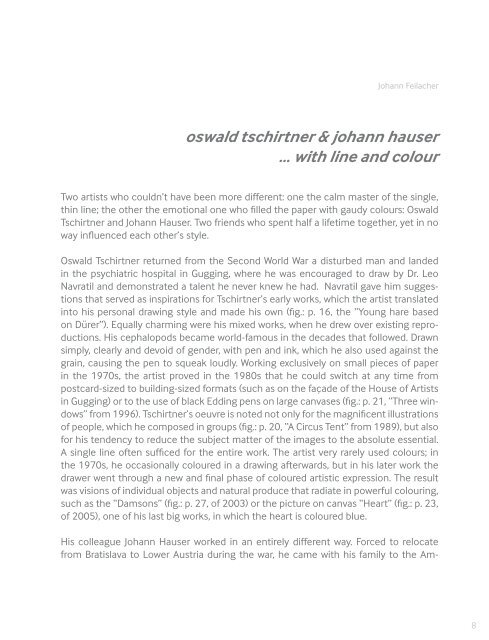Katalog_tschirtner_hauser (1)
Sie wollen auch ein ePaper? Erhöhen Sie die Reichweite Ihrer Titel.
YUMPU macht aus Druck-PDFs automatisch weboptimierte ePaper, die Google liebt.
Johann Feilacher<br />
oswald <strong>tschirtner</strong> & johann <strong>hauser</strong><br />
... with line and colour<br />
Two artists who couldn’t have been more different: one the calm master of the single,<br />
thin line; the other the emotional one who filled the paper with gaudy colours: Oswald<br />
Tschirtner and Johann Hauser. Two friends who spent half a lifetime together, yet in no<br />
way influenced each other’s style.<br />
Oswald Tschirtner returned from the Second World War a disturbed man and landed<br />
in the psychiatric hospital in Gugging, where he was encouraged to draw by Dr. Leo<br />
Navratil and demonstrated a talent he never knew he had. Navratil gave him suggestions<br />
that served as inspirations for Tschirtner’s early works, which the artist translated<br />
into his personal drawing style and made his own (fig.: p. 16, the “Young hare based<br />
on Dürer”). Equally charming were his mixed works, when he drew over existing reproductions.<br />
His cephalopods became world-famous in the decades that followed. Drawn<br />
simply, clearly and devoid of gender, with pen and ink, which he also used against the<br />
grain, causing the pen to squeak loudly. Working exclusively on small pieces of paper<br />
in the 1970s, the artist proved in the 1980s that he could switch at any time from<br />
postcard-sized to building-sized formats (such as on the façade of the House of Artists<br />
in Gugging) or to the use of black Edding pens on large canvases (fig.: p. 21, “Three windows”<br />
from 1996). Tschirtner’s oeuvre is noted not only for the magnificent illustrations<br />
of people, which he composed in groups (fig.: p. 20, “A Circus Tent” from 1989), but also<br />
for his tendency to reduce the subject matter of the images to the absolute essential.<br />
A single line often sufficed for the entire work. The artist very rarely used colours; in<br />
the 1970s, he occasionally coloured in a drawing afterwards, but in his later work the<br />
drawer went through a new and final phase of coloured artistic expression. The result<br />
was visions of individual objects and natural produce that radiate in powerful colouring,<br />
such as the “Damsons” (fig.: p. 27, of 2003) or the picture on canvas “Heart” (fig.: p. 23,<br />
of 2005), one of his last big works, in which the heart is coloured blue.<br />
His colleague Johann Hauser worked in an entirely different way. Forced to relocate<br />
from Bratislava to Lower Austria during the war, he came with his family to the Am-<br />
8


